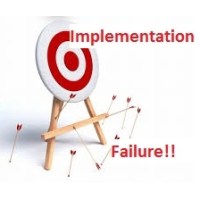An Insight into Why ERP Implementation Fails
It is reported that, more than 29% of Enterprise Resource Planning (ERP) Implementation fails to suit and deliver the planned business aids. As people see, IT as an essential functional requirement for operational efficiency, ERP comes as a heart and soul of IT.
ERP plays a central governing and collaborating tool for the organization which gives a principal input to management to apprehend it’s customers, creditors and their capital and human resources. These inputs are vital in the sense that it directly determines and effects the vision, mission and goals of an organization. Implementing or upgrading any ERP application is a route to change management, where most of the company fails to connect it to lime light and thus becomes a nightmare. We have few cases of adverse impression of some of well-known organizations charging ERP vendors for their undesired results. According to CIO magazines, firms like FoxMeyer Drug, US Navy and Hershey Food have been on the top of the list when it comes to see the implementation failures and their impacts.
There is no doubt, that implementing ERP is subject to withstand pitfalls of business complexity, the nature and kind of business to be automated and the customization required to fit the business cycle. The process of ERP implementation starts with analyzing the functional operations i.e. the day to day routine of key employees, policies, terms and conditions and many more to suit the business norms. This also includes their primary IT adaptation and the changes required to mitigate the rigidity to overcome challenges. As we are aware of the cost, organizations need to occur to come up with this kind of overall change management, the result to failure is the cause of coupling reasons which starts from defining scope to user level training. Thus, we can see a need of role of project management, specifically into to Business Analysis especially, a person who understand and gather requirements, analyses the gap and generates the feasibility.
Business Analyst is the key person to drive the change management of any firm and thereby investigate pain points of such a complex business cycle and thus plans the transformation of business processes that best fits for growth and efficiency. Blaming a lone factor responsible for improper implementation of advance application will be delusion to admit catastrophe. We should also understand the roles involved in such a complex projects and thereby both customer and vendor should go hand in hand to provide a successful product to the organization.
Listening to the fear of implementing the ERP is daunting to many customers which consequently converts a foundation to resistance. However, a wrong product selection will be more haunting experience. When ERP fails, companies can’t generate right invoices or ship products which directly impacts the customer satisfaction. There are many important reasons due to which a prolong implementation has risk of failure:
1. Nature of Cost
Cost is known to be the biggest threat for undesired results. Out of 10 ERP failures 3 to 4 are due to improper selection of vendors who are offer very low cost products resulting in less accurate system whose breaks are hard to digest and maintain at a later stage. This is to be understood that spending in IT infrastructure is not an expenditure but an investment.
2. Unclear Objectives
Every business has their operational goals and the budget allocated are on the base of targeting smooth functioning of complete business. Often due to unclear difficulties, ERP implementation fails before it is even planned. For even a small error or difficulties in operational activities companies see a greener side of grass in need of implementing or switching to different expensive customized products which possess high risk. When a simple add-on application can address the issue, opting a new ERP is definitely a bad choice.
3. Non-Involvement of Key Stakeholders
Most of the project involves consultant and project managers who lead the implementation with additional resources they bring. Even though the expertise lies within the implementation team the driving factor also plays a crucial role. The involvement of key stakeholder and the driving committee effects the quality of the product build. Lack of proper support and right decisions, most of the ERP tends to fail with shoddier experience.
4. Non-Definite Requirements
Instigating ERP automates business processes and improves efficiency in various operational activities. Therefore, this requires to define the process and authorization in a detailed way. The clearer picture can provide a path to customize and build a functionally accurate system which forms foundations of ERP. We should also know that, gathering requirements for building automated system and fixing operational processes are not phases of projects, they provide the vision for ERP implementation. This goal needs a clear understood assembly involving key departmental users, HODs, stakeholders and implementing team to discuss and attain concluding directions to the product methodology.
5. Inadequate Testing Standards and Project Timeline
When it comes to production, quality is necessary, the standards are to be met and the requirements should be fulfilled. In ERPs, Quality Assurance also share equal responsibilities. Be it a functional requirements or reporting, a tester should be thorough with the business process and the kind of system built for the clients. Once a system is ready for testing, a dedicated and accurate testing can be a savior for the system. Failing to do so or choosing a quick way of delivering products can be killer move!
Project Timeline is also a key reason behind many projects to be unsuccessful. As customer thrives to get a new system without any hindrance to current, system there is always a race to delivery. Due to this unconditional race and diversion to actual objectives, the need may get skipped and product may not be best fit. Thus, in the process of managing change, there are many aspects to be looked closely, which needs a detailed time investment to deliver the best product.
6. Lack of Proper UAT
Since organizations work to transform their manual operations to automations, it should be handled carefully and shouldn’t be done in a flurry manner. User Acceptance Test (UAT) is an assertion to deliver promises. A fine gathering enables stakeholders to analyze the product before final delivery so as to support the implementation. A last minute review is always a boon to recover snags.
Similarly, the users should be given appropriate preparation to accept their new working model, for right amount of time and knowledge about the product. This will help the users to get hands on experience before switching to newly built system. A bad experience with ERP may result to high churn rate. All possible users should be trained to prevent loss due to user level errors, which may degrade the optimal usage of ERP.
7. Data Management Challenges
When organizations are skeptic on data ownership, the user authority controlling becomes little difficult. Clients should be more thorough with the decisions on consolidations and mode of extracting data out of the system for more effective decision making. Often, more than 2 database create a major burden on the ERP solution rather harvesting benefits out of them.
ERPs are like a backbone of a business, implementing an ERP is like connecting nervous system. Thus, ERP implementation should be attempted with clear objectives and resilient reasons which need to be properly addressed and a better strategy is needed than just a plan.






















These are just a few reasons why many organizations drag their feet when it comes to ERP installation and changes. As such, it s even worse when the installation or upgrade project is failing.
Learnt on key notes of ERP implementation which would help in any kind of software/IT development.
You can also include the use of documentation and Training documentation which will help user to perform task better which will allow harvest results as expected.
Great research…. hope to see more stuff in future
Short, simple, easy to understand… All aspects are covered.. Implementation of such software needs pre planned strategies… these points will add values to the strategies
Nice article. Worth reading…